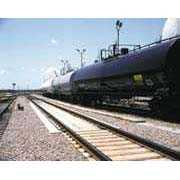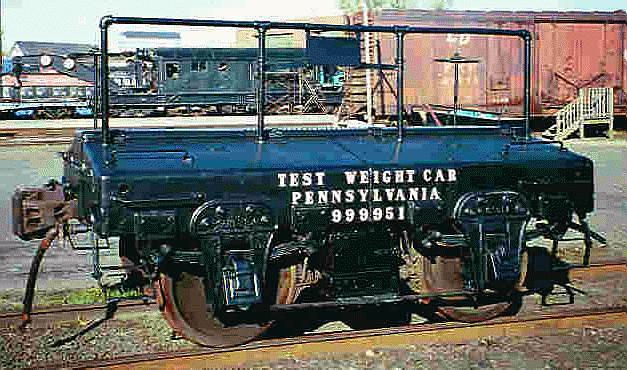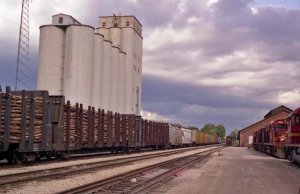Freight Car Scale?
- Thread starter LoudMusic
- Start date
You are using an out of date browser. It may not display this or other websites correctly.
You should upgrade or use an alternative browser.
You should upgrade or use an alternative browser.
I have seen automated hump yards in action and a scale is necessary for those I think.
They have to weigh each car so the retarders built into the downhill track can apply the right amount of braking as the car rolls to its destination track in the yard, with just enough speed to allow it to bump into the car already there to automatically engage the coupler.
Hump yards are real big though and takes up lots of space.
They have to weigh each car so the retarders built into the downhill track can apply the right amount of braking as the car rolls to its destination track in the yard, with just enough speed to allow it to bump into the car already there to automatically engage the coupler.
Hump yards are real big though and takes up lots of space.
I thought they used speed sensors, but I guess they could do it with weight as well. I sat and watched the UP hump yard in North Little Rock for a couple hours one day. It is overwhelmingly huge. And to think it's all operated by just a few guys at a time is really amazing.
There are plenty of scales in the coal fields, for example. Coal, ore, and other bulk commodities are sold by weight. After a car is loaded it is weighed, with the weight of an empty car subtracted, to find out how much each shipment is and how much has been purchased. There are countless references to railroad scales in any of the numerous books and (presumably) webpages on the subject of coal field railroads.
Seems to me all one would need to model a scale would be a small structure for the operator to be housed in, a concrete pad to simulate the scale, and some simulated by-pass rails to keep the locomotives off the "scale." (Remember that it's not the weight of the locomotives that needs to be rerouted but the torque they exert on the rails that would damage the equipment.)
Seems to me all one would need to model a scale would be a small structure for the operator to be housed in, a concrete pad to simulate the scale, and some simulated by-pass rails to keep the locomotives off the "scale." (Remember that it's not the weight of the locomotives that needs to be rerouted but the torque they exert on the rails that would damage the equipment.)
UP's North Platt yard in Nebraska is known as the world's largest rail yard. From what the History channel say's it's 8 miles long and 2 miles wide. Now that's a yard. They showed the scales that the car's are weighed on right before they are cut loose on the top of the hump. Pretty neat process. KCS is supposed to be rebuilding Deramus yard here in Shreveport and making it a hump yard. It'll be a while before it's finished but I will be there when it's in full operation.
Brian Schmidt said:There are plenty of scales in the coal fields, for example. Coal, ore, and other bulk commodities are sold by weight. After a car is loaded it is weighed, with the weight of an empty car subtracted, to find out how much each shipment is and how much has been purchased. There are countless references to railroad scales in any of the numerous books and (presumably) webpages on the subject of coal field railroads.
Seems to me all one would need to model a scale would be a small structure for the operator to be housed in, a concrete pad to simulate the scale, and some simulated by-pass rails to keep the locomotives off the "scale." (Remember that it's not the weight of the locomotives that needs to be rerouted but the torque they exert on the rails that would damage the equipment.)
See, I'd always thought they measured it in volume and then calculated the weight from smaller measurements. But it also makes sense to have a scale around for more accurate measurements.
And as you can imagine it's really damn tough to search for this on the web. All my results are about model railroading "in scale". But I finally found this obnoxiously long link.
http://us.mt.com/mt/filters/product...es/rail_scales_0x0002463400026bea00054e2a.jsp

Pretty non-descript looking. This one for measuing cars in motion has a bit more to look at.
http://us.mt.com/mt/filters/product...cim_rail_scale_0x0002463400026bea00054f5f.jsp
Anyway, thanks for the info!
Definitely. And it might add a nice element to a larger modern layout.
Mostly I'm just keeping my mind busy while I wait for the opportunity to get started on a narrow gauge logging line. Definitely won't be installing a car scale
Though you know what. It might be interesting to engineer a scale for an old logging line. Purely mechanical, I think it could use some levels with suspended track and a counter weight of suspended water tank. Start the session with a full tank and drain water into another tank until the car tips the scale. With the counter weight water tank marked with measurements you'd get a good relatively quick measurement of the weight of the train. You could even leave the cars coupled. The scale track would only need to drop a scale inch or two. As soon as it tips cut off the water drain and mark the water level. 8.3 pounds to the gallon
Now THAT would be something to look at.
Mostly I'm just keeping my mind busy while I wait for the opportunity to get started on a narrow gauge logging line. Definitely won't be installing a car scale
Though you know what. It might be interesting to engineer a scale for an old logging line. Purely mechanical, I think it could use some levels with suspended track and a counter weight of suspended water tank. Start the session with a full tank and drain water into another tank until the car tips the scale. With the counter weight water tank marked with measurements you'd get a good relatively quick measurement of the weight of the train. You could even leave the cars coupled. The scale track would only need to drop a scale inch or two. As soon as it tips cut off the water drain and mark the water level. 8.3 pounds to the gallon
Now THAT would be something to look at.
Car scales have been around for a while--and an interesting piece of rolling stock is a special car used to calibrate scales, with a known weight. The ones I have seen (in photos, admittedly) were short cars with a heavy weight on them. They even include special brakes (or no brakes) in order to avoid changing weights from the brake shoes wearing away.
jetrock said:Car scales have been around for a while--and an interesting piece of rolling stock is a special car used to calibrate scales, with a known weight. The ones I have seen (in photos, admittedly) were short cars with a heavy weight on them. They even include special brakes (or no brakes) in order to avoid changing weights from the brake shoes wearing away.
Wow, that sounds like they take it pretty seriously. I suppose they give them a good scrub down and dry off before calibration as well - wouldn't want some dirt throwing the measurement.
I found an interesting pictures of a scale here: http://www.railroadmichigan.com/greenbaywestern04.html
The engines were apparently too heavy, so they used this switch to only let cars go over the scale.
The engines were apparently too heavy, so they used this switch to only let cars go over the scale.
Attachments
AlienKing said:The engines were apparently too heavy, so they used this switch to only let cars go over the scale.
As I posted above, it wasn't because locomotives were too heavy but rather because of the force they exerted on the rails which would tear up the equipment. This is a common problem at grain elevators when over-zealous drivers damage the equipment with their semi truck or tractor on the scale. It's also the same reason idler cars are used to load and unload carfloats, the tractive force of the locomotive(s) would tear apart the approach tracks.
Here is a photo of a scale test car. This one weighs only 30,000 pounds, which is why it is retired. Current federal regulations require a minimum test weight of 80.000 pounds.

The weight was acheived in two ways. One, from the weight of the car itself, and, two, from loading scrap metal into it.

The weight was acheived in two ways. One, from the weight of the car itself, and, two, from loading scrap metal into it.


